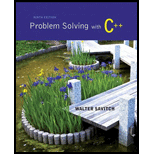
Consider a graphics system that has classes for various figures—rectangles, squares, triangles, circles, and so on. For example, a rectangle might have data members for height, width, and center point, while a square and circle might have only a center point and an edge length orradius, respectively. In a well-designed system, these would be derived from a common class, Figure. You are to implement such a system. The class Figure is the base class. You should add only Rectangle and Triangle classes derived from Figure. Each class has stubs for member functions erase and draw. Each of these member functions outputs amessage telling what function has been called and what the class of the calling object is. Since these are just stubs, they do nothing more than output this message. The member function center calls the erase and draw functions to erase and redraw the figure at the center. Since you have only stubs for erase and draw, center will not do any “cantering” but will call the member functions erase and draw. Also add an output message in the member function center that announces that center is being called. The member functions should take no arguments.
There are three parts to this project:
a. Write the class definitions using no virtual functions. Compile andtest.
b. Make the base class member functions virtual. Compile and test.
c. Explain the difference in results.
For a real example, you would have to replace the definition of each of these member functions with code to do the actual drawing. You will be asked to do this in
Use the following main function for all testing:
| //This program tests Programming Project 5. #include <iostream> #include "figure.h" #include "rectangle.h" #include "triangle.h" using std::cout; int main( ) { Triangle tri; tri.draw( ); cout<< "\nDerived class Triangle object calling center( ).\n"; tri.center( ); //Calls draw and center Rectangle rect; rect.draw( ); cout<< "\nDerived class Rectangle object calling center().\n"; rect.center( ); //Calls draw and center return 0; } |
Want to see the full answer?
Check out a sample textbook solution
Chapter 15 Solutions
Problem Solving with C++ (9th Edition)
Additional Engineering Textbook Solutions
Starting Out With Visual Basic (8th Edition)
Starting Out with Java: From Control Structures through Objects (7th Edition) (What's New in Computer Science)
Computer Science: An Overview (13th Edition) (What's New in Computer Science)
Thinking Like an Engineer: An Active Learning Approach (4th Edition)
SURVEY OF OPERATING SYSTEMS
Management Information Systems: Managing The Digital Firm (16th Edition)
- For this question you will perform two levels of quicksort on an array containing these numbers: 59 41 61 73 43 57 50 13 96 88 42 77 27 95 32 89 In the first blank, enter the array contents after the top level partition. In the second blank, enter the array contents after one more partition of the left-hand subarray resulting from the first partition. In the third blank, enter the array contents after one more partition of the right-hand subarray resulting from the first partition. Print the numbers with a single space between them. Use the algorithm we covered in class, in which the first element of the subarray is the partition value. Question 1 options: Blank # 1 Blank # 2 Blank # 3arrow_forward1. Transform the E-R diagram into a set of relations. Country_of Agent ID Agent H Holds Is_Reponsible_for Consignment Number $ Value May Contain Consignment Transports Container Destination Ф R Goes Off Container Number Size Vessel Voyage Registry Vessel ID Voyage_ID Tonnagearrow_forwardI want to solve 13.2 using matlab please helparrow_forward
- a) Show a possible trace of the OSPF algorithm for computing the routing table in Router 2 forthis network.b) Show the messages used by RIP to compute routing tables.arrow_forwardusing r language to answer question 4 Question 4: Obtain a 95% standard normal bootstrap confidence interval, a 95% basic bootstrap confidence interval, and a percentile confidence interval for the ρb12 in Question 3.arrow_forwardusing r language to answer question 4. Question 4: Obtain a 95% standard normal bootstrap confidence interval, a 95% basic bootstrap confidence interval, and a percentile confidence interval for the ρb12 in Question 3.arrow_forward
 Microsoft Visual C#Computer ScienceISBN:9781337102100Author:Joyce, Farrell.Publisher:Cengage Learning,
Microsoft Visual C#Computer ScienceISBN:9781337102100Author:Joyce, Farrell.Publisher:Cengage Learning, C++ Programming: From Problem Analysis to Program...Computer ScienceISBN:9781337102087Author:D. S. MalikPublisher:Cengage Learning
C++ Programming: From Problem Analysis to Program...Computer ScienceISBN:9781337102087Author:D. S. MalikPublisher:Cengage Learning EBK JAVA PROGRAMMINGComputer ScienceISBN:9781337671385Author:FARRELLPublisher:CENGAGE LEARNING - CONSIGNMENT
EBK JAVA PROGRAMMINGComputer ScienceISBN:9781337671385Author:FARRELLPublisher:CENGAGE LEARNING - CONSIGNMENT C++ for Engineers and ScientistsComputer ScienceISBN:9781133187844Author:Bronson, Gary J.Publisher:Course Technology Ptr
C++ for Engineers and ScientistsComputer ScienceISBN:9781133187844Author:Bronson, Gary J.Publisher:Course Technology Ptr EBK JAVA PROGRAMMINGComputer ScienceISBN:9781305480537Author:FARRELLPublisher:CENGAGE LEARNING - CONSIGNMENTProgramming Logic & Design ComprehensiveComputer ScienceISBN:9781337669405Author:FARRELLPublisher:Cengage
EBK JAVA PROGRAMMINGComputer ScienceISBN:9781305480537Author:FARRELLPublisher:CENGAGE LEARNING - CONSIGNMENTProgramming Logic & Design ComprehensiveComputer ScienceISBN:9781337669405Author:FARRELLPublisher:Cengage





